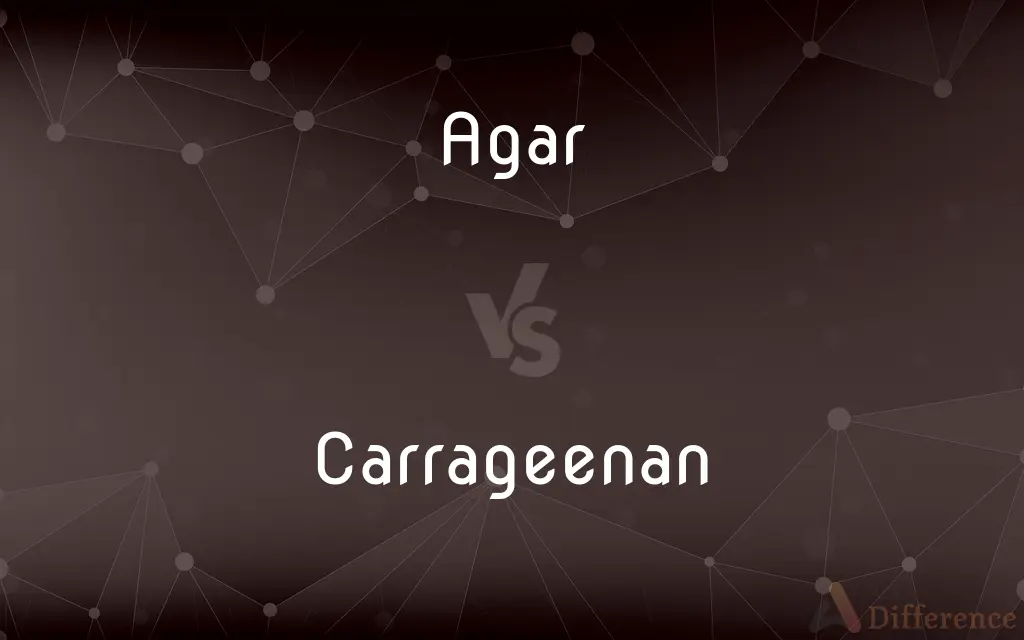Agar vs. Carrageenan — What's the Difference?
By Maham Liaqat & Fiza Rafique — Updated on March 20, 2024
Agar is a gelatinous substance derived from red algae, while carrageenan is extracted from seaweed for its thickening properties.

Difference Between Agar and Carrageenan
Table of Contents
ADVERTISEMENT
Key Differences
Agar, extracted from specific red algae species, is renowned for its ability to form strong, versatile gels at low concentrations, making it popular in culinary applications and microbiology. Carrageenan, also sourced from red algae, is primarily used as a thickener and stabilizer in the food industry, due to its ability to bind with proteins and improve texture in dairy and meat products.
The gelling properties of agar set it apart; it forms firm, non-reversible gels that do not melt at room temperature, ideal for high-precision work in laboratories and as a vegetarian gelatin substitute in cooking. Carrageenan, on the other hand, produces softer gels and is valued for its interaction with dairy proteins, enhancing the mouthfeel and stability of products like ice cream and yogurt.
From an environmental and sustainability perspective, both agar and carrageenan are considered eco-friendly alternatives to animal-derived gelatins. They are harvested from renewable seaweed sources, which do not require fertilizers, pesticides, or fresh water to grow. However, the sustainability of these products also depends on responsible farming and harvesting practices to prevent depletion and ecological damage.
In terms of health and dietary considerations, agar is often cited for its high fiber content and potential digestive health benefits. Carrageenan, while generally recognized as safe, has faced scrutiny and debate over its digestibility and potential inflammatory effects, leading some health-conscious consumers and organizations to advocate for its limited use or alternatives in food products.
Innovation in the use of both agar and carrageenan continues to evolve, with applications extending beyond food into biotechnology, pharmaceuticals, and even sustainable packaging solutions, reflecting their versatility and the growing demand for plant-based products.
ADVERTISEMENT
Comparison Chart
Source
Red algae species
Red seaweed varieties
Main Use
Gelatin substitute in culinary and culture medium in microbiology
Thickener and stabilizer in the food industry
Gelling Properties
Forms strong, non-reversible gels
Produces soft gels, interacts well with dairy proteins
Environmental Impact
Sustainable, requires no fresh water, fertilizers, or pesticides
Eco-friendly but depends on responsible harvesting
Health Considerations
High fiber, potential digestive benefits
Scrutiny over digestibility and potential inflammatory effects
Compare with Definitions
Agar
A gelatinous substance obtained from red algae used in food and scientific applications.
Agar is a key ingredient in making vegetarian jelly.
Carrageenan
A polysaccharide extracted from red seaweed, used as a food additive for thickening and stabilizing.
Carrageenan is often added to ice cream to improve its texture.
Agar
Extracted in a process that involves boiling the algae and filtering out the solids.
Agar production is an eco-friendly process, utilizing abundant seaweed.
Carrageenan
It interacts with dairy proteins, making it ideal for dairy products.
Carrageenan is used in yogurt to ensure a smooth, creamy consistency.
Agar
Agar gels are heat-resistant and do not melt at room temperature.
Agar-based desserts are ideal for warm climates due to their stability.
Carrageenan
Its use in the food industry is widespread but controversial due to health debates.
Some health-conscious consumers prefer carrageenan-free products.
Agar
High in dietary fiber and has potential health benefits for the digestive system.
Consuming agar-based products can aid in digestion and promote gut health.
Carrageenan
Available in different grades, each suited to different applications.
Kappa carrageenan forms strong, rigid gels, while iota carrageenan produces soft gels.
Agar
Known for its strong gelling properties, making it invaluable in microbiology.
Scientists use agar as a culture medium to grow bacteria.
Carrageenan
Carrageenan's extraction involves separating it from the seaweed using alkaline solutions.
The processing of carrageenan is carefully controlled to ensure purity and safety.
Agar
Agar ( or ), or agar-agar, is a jelly-like substance obtained from red algae.Agar is a mixture of two components: the linear polysaccharide agarose and a heterogeneous mixture of smaller molecules called agaropectin. It forms the supporting structure in the cell walls of certain species of algae and is released on boiling.
Carrageenan
Carrageenans or carrageenins ( karr-ə-gee-nənz, from Irish carraigín, "little rock") are a family of natural linear sulfated polysaccharides that are extracted from red edible seaweeds. The most well-known and still most important red seaweed used for manufacturing the hydrophilic colloids to produce carrageenan is Chondrus crispus (Irish moss) which is a dark red parsley-like plant that grows attached to the rocks.
Agar
A gelatinous substance obtained from certain red seaweeds and used in biological culture media and as a thickener in foods.
Carrageenan
Any of a group of closely related colloids derived from Irish moss and several other red algae, widely used as a thickening, stabilizing, emulsifying, or suspending agent in industrial, pharmaceutical, and food products.
Agar
A gelatinous material derived from certain marine algae. It is used as a base for bacterial culture media and as a stabilizer and thickener in many food products.
Carrageenan
A food additive made from a purified extract of red seaweed, commonly used as a thickening agent.
Agar
A culture medium containing this material.
Carrageenan
A colloidal material obtained from seaweed or Irish moss, used as an thickening or emulsifying agent and for stabilizing foods, cosmetics, and pharmaceuticals.
Agar
A gelatinous material obtained from red algae, especially Gracilaria species, used as a bacterial culture medium, in electrophoresis and as a food additive.
Carrageenan
A colloidal extract from carrageen seaweed and other red algae
Agar
A culture medium based on this material.
Agar
Agarwood
Agar
Common shortened form of agar-agar{2}.
Agar
Any culture medium that uses agar as the gelling agent; - used especially with a modifying prefix, as, EMB agar. The term is applied both to the dehydrated medium powder containing agar and to the gelatinous medium prepared from it.
Agar
Any culture medium that uses agar as the gelling agent
Agar
A colloidal extract of algae; used especially in culture media and as a gelling agent in foods
Common Curiosities
What is agar used for?
Agar is used as a vegetarian gelatin substitute in cooking and as a culture medium in microbiology.
Can agar form gels at room temperature?
Yes, agar forms strong, non-reversible gels that do not melt at room temperature, making it ideal for various applications.
Can agar be used in sustainable packaging?
Yes, innovations include using agar in biodegradable and sustainable packaging solutions.
Is agar environmentally sustainable?
Yes, agar is considered environmentally sustainable as it is derived from seaweed that does not require fertilizers, pesticides, or fresh water.
How does carrageenan function in food products?
Carrageenan acts as a thickener and stabilizer, particularly in dairy and meat products, enhancing texture and stability.
What are the health concerns associated with carrageenan?
Carrageenan has faced scrutiny for its digestibility and potential inflammatory effects, leading to debates about its safety in food.
What are the different types of carrageenan and their uses?
The main types are kappa, iota, and lambda carrageenan, each with different gelling properties and uses in food and non-food products.
Why is carrageenan popular in the dairy industry?
Carrageenan is popular in the dairy industry for its ability to interact with proteins, improving the mouthfeel and stability of dairy products.
Are there any dietary benefits to consuming agar?
Agar is high in fiber, which can aid digestion and promote gut health.
Are there any sustainable harvesting concerns for carrageenan?
Sustainable harvesting practices are important for carrageenan production to prevent ecological damage and ensure long-term availability.
How is carrageenan extracted from seaweed?
Carrageenan is extracted using alkaline solutions that separate it from the seaweed material.
How does the gelling strength of agar compare to gelatin?
Agar has a stronger gelling ability than gelatin, requiring lower concentrations to form gels.
Is carrageenan considered vegan?
Yes, carrageenan is vegan as it is derived from seaweed and does not contain any animal products.
How do agar and carrageenan contribute to food texture?
Agar creates firm, stable gels, enhancing the texture of desserts and jellies, while carrageenan improves the creaminess and consistency of dairy products.
What role do agar and carrageenan play in vegetarian and vegan diets?
Both agar and carrageenan offer plant-based alternatives to animal-derived gelatin, expanding options for vegetarian and vegan food products.
Share Your Discovery

Previous Comparison
Balaclava vs. Baklava
Next Comparison
Sonnet vs. PoemAuthor Spotlight
Written by
Maham LiaqatCo-written by
Fiza RafiqueFiza Rafique is a skilled content writer at AskDifference.com, where she meticulously refines and enhances written pieces. Drawing from her vast editorial expertise, Fiza ensures clarity, accuracy, and precision in every article. Passionate about language, she continually seeks to elevate the quality of content for readers worldwide.
















































